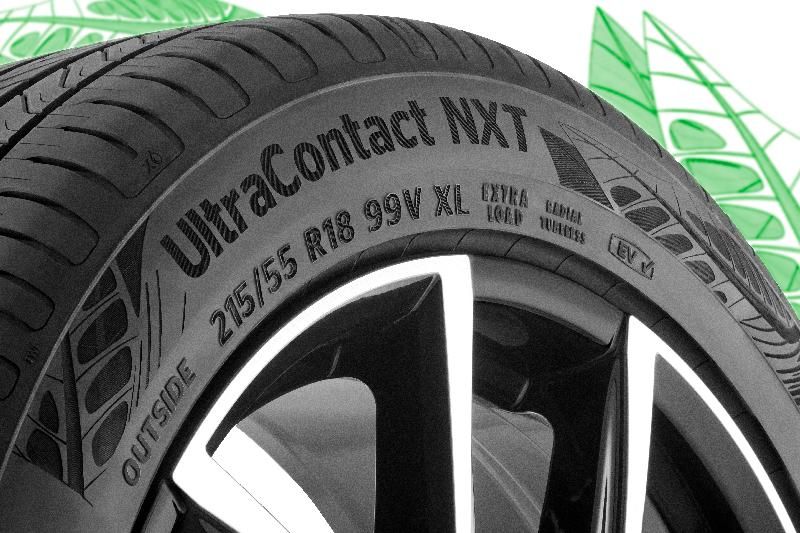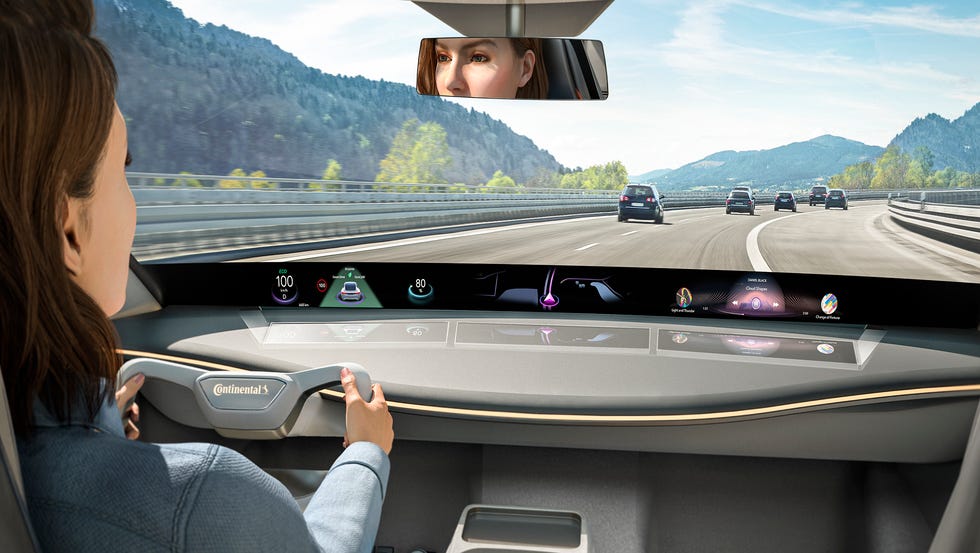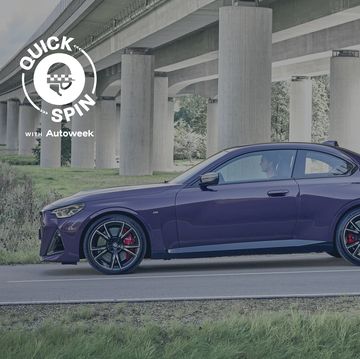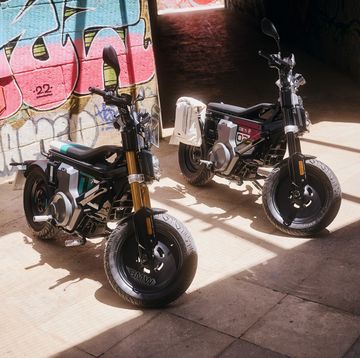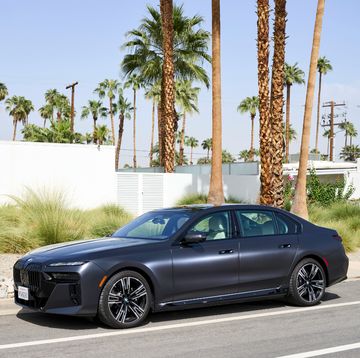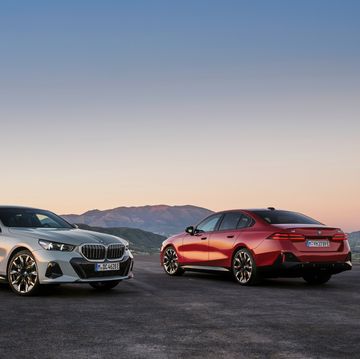- Continental is talking to automakers about using a version of its Automated Valet Parking system for times when a lot of vehicles need to be moved around.
- The company’s UltraContact NXT tire has up to 65% more sustainable materials like recycled bottles and silicate taken from rice husk ash—that means up to 5% recycled and up to 32% renewable materials.
- Conti’s new Scenic View head-up display (HUD) turns the entire bottom of a windshield into a HUD that looks as bright and crisp as a traditional screen.
Continental’s history stretches back 150 years, but there’s no doubt the German automotive supplier’s primary focus is on what’s coming next. In addition to next-generation tires, the supplier recently showcased around two dozen technologies that will make their way into new cars in the coming years. From garages that take control of your vehicle to tires that talk, here are some highlights of what Continental is working on.
Automated Valet Parking
Automated parking technologies available today, like Tesla’s Smart Summon and Hyundai’s Remote Smart Park Assist system, require in-vehicle sensors and intelligence. Continental is working on these intelligent vehicle (Type 1) systems, but that’s not the only strategy to get cars to park themselves.
Called Automated Valet Parking Type 2, Continental’s intelligent infrastructure system uses an entirely different method of having cars move themselves through a parking garage. It’s so different that many modern vehicles can be turned into slow-moving, 1:1 scale RC models with the proper software updates.
“The [intelligent] infrastructure system has the advantage that almost any car today has most of the equipment needed to drive,” said Continental’s Kent Young. That equipment includes an automatic transmission, a way to control the steering and propulsion, and a wireless communication module. A smart parking garage can be outfitted with software, transmitters, and a new kind of QR code that lets the garage take control of a vehicle and move it into an empty parking space at speeds of up to around seven mph. Today, anyway. Continental’s system can simultaneously control a few dozen vehicles at speeds up to 12 mph.
Type 1 systems are more expensive for car buyers because of all the hardware and computing power that needs to be installed in the vehicle at the factory, Young said. Type 2 systems are more expensive for builders and operators of parking garages, but they allow more cars to take advantage of auto parking.
Advanced Asian cities like Taiwan and Singapore will likely be the first places the public can use Type 2 AVP. Continental is also talking to automakers about using a version of Type 2 AVP called infrastructure-based marshaling (IOM) when a lot of vehicles need to be moved around—getting finished vehicles from the end of a production line and into a staging area, for example—or getting vehicles on or off an ocean-going car carrier. Because a human driver doesn’t need to open the door to get out, the cars can be parked closer together, Young said.
Scroll for Video of Continental’s Automated Valet Parking
“Once the automakers are building cars with this capability that are able to be driven by these systems, then they’ll go into the marketplace, and the automakers can sell it as a feature,” he said. “The parking garages also want this technology because they see an increased potential for revenue and service.”
Continental expects to launch its AVP Type 2 tech in 2024. Valeo (with BMW) and Bosch are two other suppliers working on their own Type 2 AVP systems.
Better Tires with More Recycling
The next step in Continental reaching its goal of having “fully circular operations” for tire production by 2050, at the latest, was the debut of the company’s “most sustainable series tire to date.” Depending on size, the UltraContact NXT tire has up to 65% more sustainable materials like recycled bottles and silicate taken from rice husk ash.
That means the new tire has up to 5% recycled materials and up to 32% renewable materials. An UltraContact NXT also contains up to 28% “mass balance” certified bio- or circular feedstock materials. Worldwide, Continental uses an average of 15% to 20% of sustainable material in its tires today.
All sizes of the UltraContact NXT scored the highest possible EU tire label rating for rolling resistance, wet braking, and exterior noise. The new tire goes on sale in Europe in July.
Dry Brakes with Less Maintenance
The UltraContact NXT fits squarely into Continental’s oft-stated sustainability goals, including reaching at least 40% sustainable materials in its tires by 2030 on the way to the 2050 goal mentioned above. As Continental CEO Nikolai Setzer said when introducing the tire, “we are convinced that [getting to full] sustainability—fast—is not an option. It’s a must.”
A small but important addition to Conti’s arsenal will be its advanced dry brakes. An evolution of the company’s first brake-by-wire system from 2016, the Future Brake Systems (FBS) 3 technology will completely eliminate hydraulics in a vehicle’s brakes. That could reduce the cost and frequency of brake maintenance. For now, tests involve a semi-dry brake system, which means hydraulics on the front tires and dry electromechanical brakes on the rear. A full-dry test system is on the way sometime between 2028 and 2030.
Software-Driven Future Mobility
Continental’s future efforts can be grouped into two distinct tracks, one devoted to improving “sustainable material competence” and the other to developing software-driven future mobility technologies. Aside from the AVP, fancy screens and sensors flourished at the event.
Continental’s Elektrobit subsidiary provides software and services to Sony Honda Mobility for its prototype EVs like the Afeela that debuted at CES in January. The car has digital cameras instead of side mirrors, and the screen zooms out a bit when you use the turn signals to give the driver a better view of the blind spot.
Continental’s new Scenic View head-up display (HUD) turns the entire bottom of a windshield into a HUD that looks as bright and crisp as a traditional screen. But, if an automaker wants a large screen, Continental is happy to provide it with its Curved Ultrawide Display, a 4.2-foot-wide screen intended to go from pillar to pillar with a hidden control panel from In2Visible installed into a woodgrain panel.
Continental was also showing its latest driver monitor sensors and driver identification technology, features that will be coming to more and more vehicles, especially in Europe, where monitoring will be required starting in 2026.
Tires aren’t left out of the future mobility question, either. The ContiConnect 2.0 connected tire tech allows fleet managers to get more real-time data from their vehicles as the rubber hits the road.
What futuristic technologies are you eager to see in next-generation vehicles? Please comment below.
Sebastian Blanco has been writing about electric vehicles, hybrids, and hydrogen cars since 2006. His articles and car reviews have appeared in the New York Times, Automotive News, Reuters, SAE, Autoblog, InsideEVs, Trucks.com, Car Talk, and other outlets. His first green-car media event was the launch of the Tesla Roadster, and since then he has been tracking the shift away from gasoline-powered vehicles and discovering the new technology's importance not just for the auto industry, but for the world as a whole. Throw in the recent shift to autonomous vehicles, and there are more interesting changes happening now than most people can wrap their heads around. You can find him on Twitter or, on good days, behind the wheel of a new EV.


